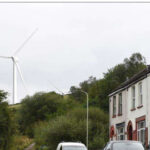UPDATED FLYERS WITH UPDATED QR CODES HERE
FOR TAKING ACTION, PLEASE VIEW OUR SUB PAGE HERE
FURTHER INFO:
Whether you believe there is any value to wind farms or not, Wales already produces almost twice as much electricity as it uses, so increasing our production is not even of benefit to us in Wales, only for the profit of corporations who are not even from Wales (in other words “not in my back yard”).
This campaign was initially in response to the planning proposed for a large scale wind farm with wind turbines that will be higher than Blackpool Tower (14 x 200m turbines) proposed for Eglwysilan/Senghenydd Common, destroying an ancient archeological site of specific interest to the true history of Wales (including an ancient star map that is not yet officially recognised). The evidence of our true history will be gone and forever become a myth or legend, just like so much of Wales’ history if this is allowed to go ahead, aside from the many ethical, environmental, ecological and economical reasons to oppose it! But we have since become aware of many other proposals, such as (to name just a few) 10 x 230m tall turbines at Mynydd Baedan, near Tondu, Bridgend, 18 x 250m turbines at Bryn between Neath Port Talbot and Bridgend and 15 x 150m turbines overlooking Cwmbran, Cwmcarn and Newbridge.
There are many areas such as Mynydd y Gaer that have already been destroyed by these monstrosities, but this is small compared to the scaling up that is happening before our very eyes, with turbines being used that have not even been approved or tested for on shore use.
WIND TURBINE FACTS TO CONSIDER:
ENERGY PRODUCTION – Wales produces a total of 27.1 TWh of electricity in 2021 yet only consumed 14 TWh of electricity. Why should the burden be upon us to produce more? The offshore capacity is enough to meet current and projected needs.
Constraints Payments – over the last decade electricity customers have paid £billions via their electricity bills to developers in constraints payment i.e. to switch them off when the grid is at full capacity.
Grid Network – shared with other energy sources, the current infrastructure has inadequate capacity to accept and store any excess energy.
Size and Scale – 14 Turbines up to 200m high with a 160m rotor diameter are proposed for Eglwysilan, Caerphilly, and up to 230m in Bridgend – this is unprecedented onshore. Turbines of this size and scale were not envisaged in any research on the adverse impacts on health, well-being, ecology, flooding etc. They are getting bigger and bigger, and we are still waiting on the legislation to deal with these sizes on shore.
BENEFITS & IMPACT – Benefits will be limited to those who gain financially, to the direct detriment of others who are concerned about loss of well-being, health, homes and livelihoods.
Reduced House Prices – proximity to a wind farm affects property value. The London School of Economics reported that those within 1.2 miles of a large wind farm would have around 13% knocked off the value of their homes, going down to 3% for those 2.5 miles away. https://www.renewableenergyhub.co.uk/main/wind-turbines/how-a-wind-turbine-is-likely-to-affect-your-property-price/
Health and Well-being – there’s concern about the impact on existing and future health conditions. Growing research on the impact of ‘noise pollution’, ‘Low Frequency Noise’/LFN & ‘Amplitude Modulation’/AM, lighting, turbine flicker, etc, on people and animals, especially in tranquil areas. The Waubra Foundation recommends a distance of 3km from the nearest turbine to avoid serious health effects. There are peer-reviewed studies being carried out and soon to be released of the detrimental effect of infrasound upon our health and well-being.
Noise Pollution – Experts say that the noise travelling from turbine blades can be heard from as far away as 10km. The closest that a wind turbine is typically placed to a home is 300m, where there is a sound pressure level of 43db. Horses who are completely calm around traffic and heavy construction are known to become very upset when they approach wind turbines.
Landscape – this will be an industrial site with significant landscape change and adverse impact on not only the site itself but also the neighbouring designated ‘Special Landscape Area’ & viewed from many miles around with compulsory lighting disrupting the dark skies. 200m turbines on top of a mountain can be 550m high!
Wildlife and Ecology – significant impact on birds, bats and insects through collision, disruption and loss of habitat. Up to 100,000 birds are killed by turbine blade strikes annually in the UK.
Construction – there are concerns about the displacement of peat by thousands of tonnes of concrete and steel for the enormous underground permanent turbine bases and required infrastructure, compounds and access roads. Each turbine construction site/ pad is approx the size of a football pitch.
Archaeological Damage – archaeology of a significant interest to the true history of Wales will be destroyed, as some is yet to be officially recognised. Even official archaeology is being disregarded when an archaeological assessment carried out by Bute Energy for the Twyn Hywel site planned for Eglwysilan Common in Caerphilly failed to fully uncover and understand the historical potential of this common land after a cup-marked stone was excluded from the assessment. https://caerphilly.observer/news/1026129/archaeologists-concerns-over-impact-of-potential-new-wind-farm-sengh/
HUMAN RIGHTS – Our objections are being ignored! The developers have all the power and resources whereas we have limited access to free or affordable help.
Community Funds – from the developer is nothing more than a ‘carrot’ to the villages’ residents, millions promised but only over the lifespan when operating/producing power and only certain projects qualify. Not compulsory and possibly not honoured if/when the operation is transferred/sold on?
Litigation and Landowners – increasing litigation against developers, true extent unknown as many cases settled out of court eg UK Davis case. Landowners cannot be guaranteed indemnity especially if projects are ‘sold on’. There is no compensation for people living close to turbines but communities usually further away are offered community benefits (bribes ) which are paltry compared to developers’ earnings.
GREEN?
Manufacture – Sourcing and manufacturing of the required materials – concrete, steel, copper, aluminium, rare minerals produces vast amounts of CO2 and has an adverse impact on the poorest countries. Turbine blades are not generally recycled and shed micro plastics/BPA pollution.
Turbine Disposal – wind turbine blades are not able to be recycled. They are made from fiberglass bound together with epoxy resin, a material so strong it is incredibly difficult and expensive to break down. Most blades end their lives in landfill due to the current limited availability and higher cost of other methods. With only 7% of UK usage being supplied by renewables, the special landfill allocation is already running out. It is estimated that 43 million tonnes of decommissioned turbine blades will accumulate by 2050.
Net Zero? – with increasing energy costs, governments are hitting targets but missing the point. Wind Turbine energy can never achieve net zero as it is reliant on other expensive unproven backup energy sources to supplement it. Each wind turbine needs 80 gallons of oil as lubricant, a PAO synthetic oil based on crude, and the oil needs to be replaced once a year. They can be prone to oil leaks but only serviced once every 6-12 months, leading to a lot of oil leakage before it is detected.
How long does it take a wind turbine to offset its carbon footprint? – Approximately 10-15 years according to 8billiontrees.
As soon as the payback period has been exceeded, approximately 10-15 years after installation, a wind turbine can attain carbon neutrality where the carbon footprint has been offset by the green energy generated. https://8billiontrees.com/carbon-offsets-credits/carbon-footprint-of-wind-turbine-construction/ Most wind turbines only have a lifespan of 20years, if they are well-maintained and if they do not fail, meaning they may only have a plus effect for 5 years.
DEMOCRACY?
Concerns – as a Development of National Significance (DNS) the application bypasses local decision making, submitted directly to the planning inspectorate to decide whether any adverse impact from the development is acceptable or not. But a single Welsh Minister can overrule the inspector’s decision “in the greater public interest”, “due to the increased climate emergency” and/or as it’s “only being for the duration of the lifetime of the development’s operation”…..which can be up to 50yrs and extended!! This overrides FW2040’s safeguard Policies 17 and 18 leaving the most affected individuals unprotected, ‘collateral damage’ and with no compensation.
First of Many – This proposal will not be the last. If approved our whole ‘pre-assessed area’ could be targeted by developers as has happened in Scotland. There have been no large-scale wind farms in England since 2016 legislation limited them, as local authorities/communities have the final say.
Scotland and Wales are destined to provide England’s energy needs, with the backing of their governments, to the detriment of their people, country and communities.
LINKS, GROUPS & INFO:
Full Map of all current DNS (Developments of National Significance) on CPRW website: CLICK HERE
Facebook Group Motvind UK: CLICK HERE
Motvind UK Website: motvinduk.org
Facebook Group Stop Onshore Wind Turbines Cymru: CLICK HERE
Article: How the Welsh Government Sold Out the Welsh Countryside by Clive Goodridge
Facebook group: Cymru Wind Farm Information
Twyn Hywel – EGLWYSILAN, SENGHENYDD & NELSON, CAERPHILLY
Facebook Group Twyn Hywel Energy Park Community Group: CLICK HERE
Objection received from Head of Soil, Peatland & Agricultural Land Use Planning Unit of the Welsh Government: CLICK HERE
Assessment Report by CCBC on a Landscape Review of the Visual Impact Assessment, showing planning had UNDERPLAYED the impact (Must see!): CLICK HERE
Some images from the report (click for full size):
Video showing a Sketch-up of how the turbines at Twyn Hywel will look from various locations (courtesy of Motvind UK):
OTHER AREAS:
Mynydd Mynyllod,Gwynedd
Website:savegaerwen.org
Facebook Group: Gaerwen Wind Farm Information
Neath Port Talbot (Y Bryn & Foel Trawsant)
Facebook Group: STOP Y Bryn & Foel Trawsnant Onshore Windfarms
Cwmbran & Surrounding (Mynydd Maen)
Facebook group: Mynydd Maen Wind Farm
Mychynlleth Powys (Esgair Galed)
Facebook Group: Esgair Galed Wind Farm Information
Please email us to be added!




